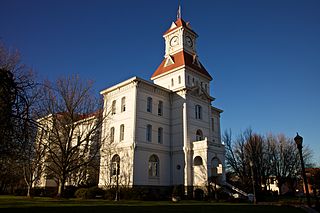
Corvallis is a city and the seat of government of Benton County in central western Oregon, United States. It is the principal city of the Corvallis, Oregon Metropolitan Statistical Area, which encompasses all of Benton County. As of the 2020 United States Census, the population was 59,922, making it the 10th most populous city in Oregon. Corvallis is the location of Oregon State University and Good Samaritan Regional Medical Center. Corvallis is the westernmost city in the contiguous 48 states with a population larger than 50,000.

The Willamette River is a major tributary of the Columbia River, accounting for 12 to 15 percent of the Columbia's flow. The Willamette's main stem is 187 miles (301 km) long, lying entirely in northwestern Oregon in the United States. Flowing northward between the Oregon Coast Range and the Cascade Range, the river and its tributaries form the Willamette Valley, a basin that contains two-thirds of Oregon's population, including the state capital, Salem, and the state's largest city, Portland, which surrounds the Willamette's mouth at the Columbia.
Historic ferries in Oregon are water transport ferries that operated in Oregon Country, Oregon Territory, and the state of Oregon, United States. These ferries allowed people to cross bodies of water, mainly rivers such as the Willamette in the Willamette Valley, and the Columbia, in order to transport goods, move people, and further communications until permanent bridges were built to allow faster crossing of the water. The early ferries were used by wagons and pedestrians, while later ones transported trains and then automobiles. Oregon has a few automobile ferries still in operation.
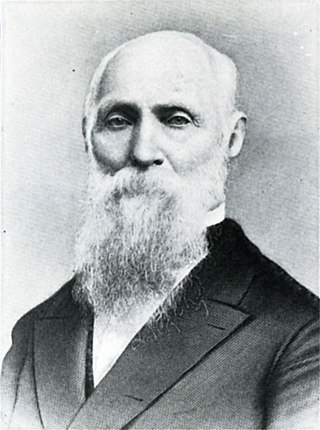
William Williams Chapman was an American politician and lawyer in Oregon and Iowa. He was born and raised in Virginia. He served as a United States Attorney in Iowa when it was part of the Michigan and Wisconsin territories, and then represented the Iowa Territory in the United States House of Representatives. He later immigrated to the Oregon Country, where he served in the Oregon Territorial Legislature.
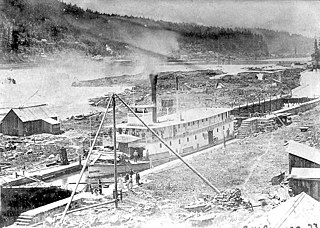
The Willamette River flows northwards down the Willamette Valley until it meets the Columbia River at a point 101 miles from the Pacific Ocean, in the U.S. state of Oregon.
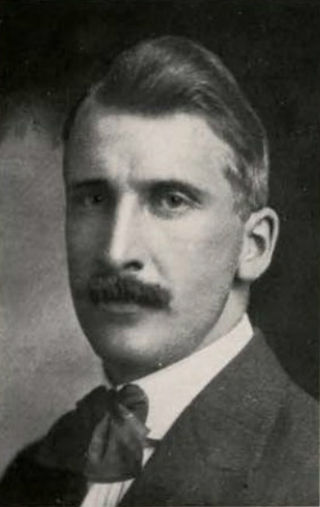
Wilfred Charles Bleamaster was an American football and basketball coach. He served as the head football coach at Carroll College—now Carroll University—in Waukesha, Wisconsin from 1909 to 1911, Alma College from 1912 to 1915, and the University of Idaho from 1916 to 1917, and Albany College—now known as Lewis & Clark College—from 1926 to 1927. Bleamaster was also the head basketball coach at Alma from 1912 to 1916 and at Idaho for the 1918–19 season, tallying a career college basketball mark of 28–29.

Launched in 1850, Lot Whitcomb, later known as Annie Abernathy, was the first steam-powered craft built on the Willamette River in the U.S. state of Oregon. She was one of the first steam-driven vessels to run on the inland waters of Oregon, and contributed to the rapid economic development of the region.

Gazelle was an early sidewheeler on the Willamette River in what is now the U.S. state of Oregon. She did not operate long, suffering a catastrophic boiler explosion on April 8, 1854, less than a month after her trial voyage. This was the worst such explosion ever to occur in the Pacific Northwest states. The wrecked Gazelle was rebuilt and operated for a few years, first briefly as the unpowered barge Sarah Hoyt and then, with boilers installed, as the steamer Señorita. A victim of the explosion was D.P. Fuller, age 28, who is buried in Lone Fir Cemetery in Portland, Oregon.

The Enterprise was an early steamboat operating on the Willamette River in Oregon and also one of the first to operate on the Fraser River in British Columbia. This vessel should not be confused with the many other vessels, some of similar design, also named Enterprise. In earlier times, this vessel was sometimes called Tom Wright's Enterprise after one of her captains, the famous Tom Wright.
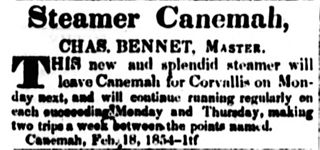
Canemah was one of the first steamboats to run on the Willamette River above Willamette Falls. Canemah was the first steamboat to load grain at Corvallis, the first to carry the mail on the Willamette River, and the first steamboat in Oregon to suffer a fatal boiler explosion.

The Christmas flood of 1964 was a major flood in the United States' Pacific Northwest and some of Northern California between December 18, 1964, and January 7, 1965, spanning the Christmas holiday.

The Southern Pacific Red Electric Lines, also known simply as the Red Electric, was a network of interurban passenger train services operated by the Southern Pacific Railroad in the Willamette Valley of the U.S. state of Oregon from 1914 to 1929. The service got its name from the bright red color of its cars. Despite its short history, among West Coast interurbans it was unique, and it was considered the finest such system in the Pacific Northwest. It was the only major electric interurban railroad converted from steam to electric passenger use. It was also one of few systems using all-steel equipment, and one of the largest 1500-volt systems in the country.

The Willamette Valley is a 150-mile (240 km) long valley in Oregon, in the Pacific Northwest region of the United States. The Willamette River flows the entire length of the valley and is surrounded by mountains on three sides: the Cascade Range to the east, the Oregon Coast Range to the west, and the Calapooya Mountains to the south.

Bernard Goldsmith was a Bavarian-American businessman and politician. He is best remembered as the 19th mayor of Portland, Oregon, serving from 1869 to 1871, and as the first Jew to hold that position.

Pomona was a steamboat which operated on the Willamette, Columbia and Cowlitz rivers from 1898 to 1940. Pomona was specially designed to operate in low water conditions such as typically prevailed in the summer months in Oregon. Pomona was one of the few steamers that could regularly navigate to Corvallis, Oregon, which was the practical head of navigation on the Willamette. In 1926, Pomona was substantially rebuilt, and served afterwards as a towboat. In 1940, Pomona was converted into an unpowered floating storehouse.
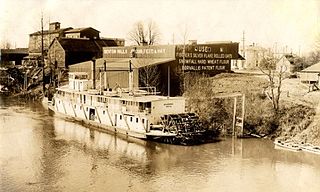
Grahamona was a sternwheel steamboat built in 1912 for the Oregon City Transportation Company, commonly known as the Yellow Stack Line. Grahamona was specially designed to serve on the shallow waters of the upper Willamette River. It was one of the largest steamboats ever to operate on the upper Willamette. In 1920, Grahamona was sold and the name was changed to Northwestern. In 1939, the vessel was sold again, and transferred to Alaska for service on the Kuskokwim River.
Bushrod Washington "Bush" Wilson (1824–1900) was a pioneer, business leader, and local politician in the American state of Oregon. He is best remembered as one of the pioneering first citizens of the town of Corvallis, Oregon, and as the founder of the Willamette Valley & Coast Railroad (WV&C), established in 1874.
The Willamette Valley & Coast Railroad (WV&C) was a small 19th-century railway line in the American state of Oregon which sought to cross the Coast Mountain Range to connect the agriculturally oriented Willamette Valley with international shipping at Yaquina Bay. Following three false starts during the ten years after the American Civil War, the railway was launched in July 1874. Work was completed on the valley-to-coast road in 1884. The line is today operated by Portland and Western Railroad.
The 1895 Oregon Agricultural Aggies football team represented Oregon Agricultural College during the 1895 college football season. The team was a member of the Oregon Intercollegiate Football Association. In their first and only year under head coach Paul Downing, the Aggies compiled a 0–2–1 record and were outscored by their opponents by a combined total of 82 to 6.
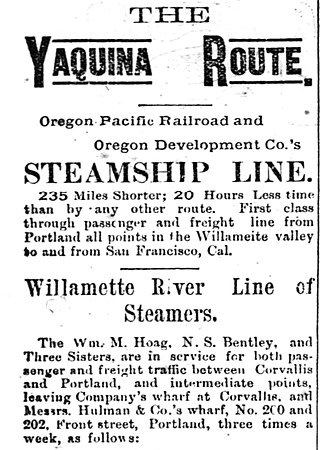
N.S. Bentley, commonly referred to as simply Bentley, was a stern-wheel driven steamboat that operated on the Willamette rivers. Launched in East Portland in December 1886, Bentley ran until 1896, when it was rebuilt and renamed Albany. Bentley was owned by the Oregon Pacific Railway, and was used as part of a rail and marine link from Portland to San Francisco, running down the Willamette, then to Yaquina Bay, and then by ocean steamer south to California. In 1896, Bentley was rebuilt and renamed Albany.

















